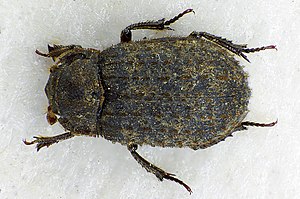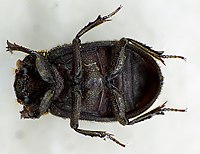Trox scaber
| Trox scaber | ||||||||||||
|---|---|---|---|---|---|---|---|---|---|---|---|---|

Trox scaber |
||||||||||||
| Systematics | ||||||||||||
|
||||||||||||
| Scientific name | ||||||||||||
| Trox scaber | ||||||||||||
| ( Linnaeus , 1767) |

|
| Front view |

|
| Side view |

|
| bottom |
Trox scaber is a beetle from the family of the common beetles (Trogidae). These were previously placed with the scarab beetles because the antennae are similar in both families. The five to eight millimeter long animal is spread almost all over the world and lives in bird nests.
The genus Trox is represented worldwide with 46 species, in Europe with 21 species, all of which belong to the subgenus Trox . About eight species are found in Central Europe. The generic name Trox (from ancient Gr . Τροξ trox rodent) possibly refers to the fact that the upper jaw is forked ( Latin maxilla bifida) The species name scaber ( Latin scaber = rough) alludes to the rough surface of the wing coverts.
Physique of the beetle
The beetle is black to black-brown, the antennae rust-red. The bristles are brownish-yellow and not black. The body is short, obovate and strongly arched.
The head is retracted into the pronotum. The antennae have ten links, the last three links form a fan that appears dull due to the fine hair. The first link of the hostage is long and slightly hollowed out on the underside. The mouthparts are directed downwards and are not level with the head shield . The upper jaws are short with a small, almost smooth grinding surface. The jaw probes are quite short, the terminal phalanx elongated. The third lip switch element is thickened ovoid.
The pronotum is bordered on the side and at the base. At the side it ends with a row of short bristles, at the base there are slightly longer bristles that are less regular. The curved disc is roughly sculpted and also has rows of bristles.
The wing covers cover the telson . Each wing cover has 10 narrow, straight and weakly dotted stripes. In between there are alternately about four times as wide, higher arched and only about three times as wide, less arched spaces. On each of the higher and wider spaces there is a row of small bumps, which are covered with short, strong bristles. The humps are missing in the narrower spaces and the bristles are much sparser and grouped in a series of very small bristle pits. The sides of the wing covers are edged with a row of short bristles.
The front chest is extended backwards between the front legs. This prosternal process is short and pointed. The abdomen shows only five sternites . The hips of the middle pair of legs are very small and rounded. The legs have five-part tarsi and the front legs are designed as grave legs due to the serrated outer edge of the rails.
Way of life
The heat-loving beetles can make chirping noises by rubbing their abdomen against the wing covers. The species is found primarily in the substructure of older, large bird nests, but also in smaller bird nests, on bird carcasses and remains of fur that they gnaw on. Occasionally they can also be found at the entrance to underground animal structures. The adults are reluctant to fly.
distribution
The species is distributed almost worldwide. In Central Europe it is common in low altitudes, in the Alps it occurs only rarely.
literature
- Heinz joy , Karl Wilhelm Harde , Gustav Adolf Lohse (ed.): The beetles of Central Europe . tape 8 . Teredilia Heteromera Lamellicornia . Elsevier, Spektrum, Akademischer Verlag, Munich 1969, ISBN 3-8274-0682-X .
- Gustav Jäger (Ed.): CG Calwer 's Käferbuch . K. Thienemanns, Stuttgart 1876, 3rd edition
- Klaus Koch : The Beetles of Central Europe Ecology . 1st edition. tape 2 . Goecke & Evers, Krefeld 1989, ISBN 3-87263-040-7 .
Individual evidence
- ↑ a b Trox (subgenus) in Fauna Europaea. Retrieved February 10, 2013
- ↑ Trox in BioLib
- ↑ Sigmund Schenkling: Explanation of the scientific beetle names (genus)
- ^ JC Fabricius: Systema entomologiae, sistens insectorum classes ... Flensburgi, Lipsiae 1775 Original description of the genus Trox at GDZ
- ↑ Sigmund Schenkling: Explanation of the scientific beetle names (species)